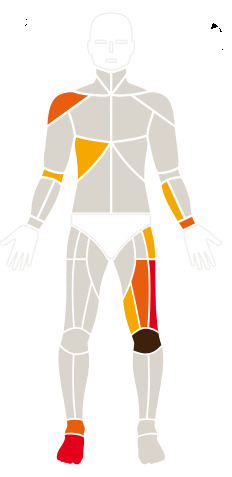Medical Thermography
Cardiovasculair Health
A Proactive Approach.

Join the Health Optimization Revolution
Thermography, also known as thermal imaging, is a non-invasive diagnostic tool that uses infrared cameras to detect and measure thermal energy emitted from the skin’s surface. This energy is translated into a visual map of temperature variations across the body. For cardiovascular health, these variations can reveal important indicators of conditions like heart disease, peripheral vascular disease, and deep vein thrombosis.
Understanding Thermography in Cardiovascular Health
Thermography visualizes and quantifies changes in skin surface temperature that reflect underlying blood flow patterns. Abnormal patterns can signal various cardiovascular issues.
How It Works: Areas of increased blood flow show higher temperatures due to the metabolic heat produced by blood. Meanwhile, reduced blood flow areas appear cooler. This distinction makes thermography an effective tool for assessing cardiovascular health.
Uses in Cardiovascular Evaluation
Thermography can aid cardiovascular assessment in several ways:
Advantages of Thermography
Thermography offers unique benefits in assessing cardiovascular health:
Clinical Studies and Research
Research supports thermography’s role in cardiovascular health. Studies show its ability to detect conditions like heart disease and peripheral vascular disease. For instance, research in the Journal of Clinical Monitoring and Computing demonstrated thermography’s effectiveness in identifying peripheral arterial disease through significant temperature differences in the lower extremities.
Ongoing research aims to refine thermographic techniques, increasing accuracy and reliability for cardiovascular diagnostics.
The Future of Prevention
Thermography is a valuable, non-invasive tool for cardiovascular health assessment. Its ability to detect early signs of disease, monitor treatment progress, and offer a comprehensive health overview makes it an essential part of modern care. As technology evolves, thermography’s role in the early detection and prevention of cardiovascular diseases is expected to grow.
Research has shown a significant connection between gum disease, dental issues, and heart disease. Inflammation and infections in the mouth, such as periodontal disease, can lead to increased levels of inflammation in the body, which is linked to a higher risk of cardiovascular problems, including heart attacks and stroke. Thermography can help detect early thermal patterns of inflammation, not just in the gums, but also in the cardiovascular system, offering insights into how dental health impacts overall heart health.
By continuing to harness thermography’s potential, both patients and healthcare providers can take proactive steps toward better heart health, prevent gum disease-related complications, and improve overall well-being.
